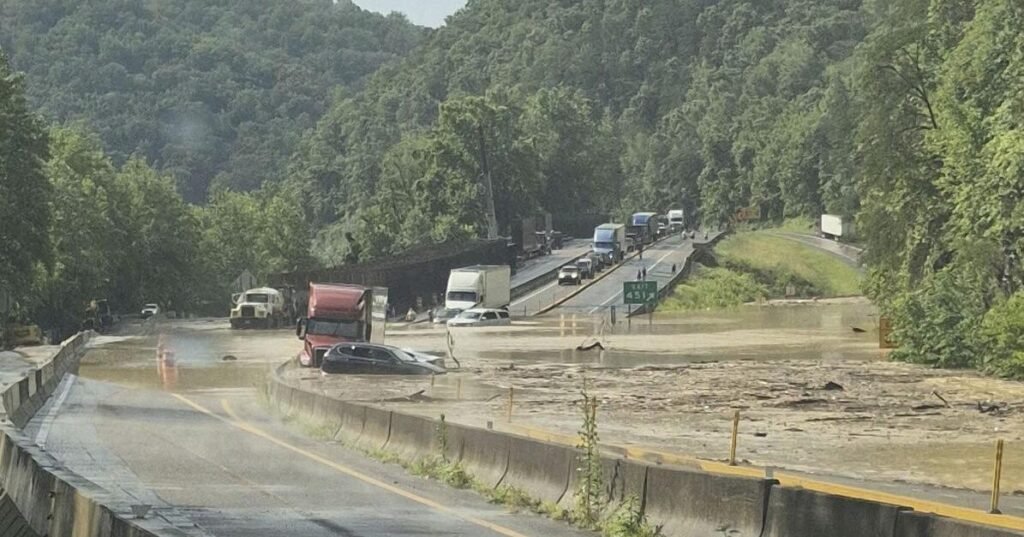Interstate 40 Closure: Rock Slide and Flooding in the Great Smoky Mountains Could Last Weeks
Living near the Great Smoky Mountains has always filled me with awe and appreciation for these ancient peaks that stand as sentinels along the Tennessee-North Carolina border. But Mother Nature occasionally reminds us of her power in ways that disrupt our daily lives. The recent closure of Interstate 40 through the Smokies is one such reminder—and it’s going to impact travelers for quite some time.
Major Highway Disruption in the Smokies
Heavy rainfall on Wednesday triggered both flooding and a significant rock slide around mile marker 450 on Interstate 40, forcing officials to close a crucial section of this coast-to-coast highway. As someone who’s traveled this winding mountain corridor countless times, I know just how vital this route is for both locals and cross-country travelers.
Engineers from the Tennessee Department of Transportation have assessed the damage and delivered sobering news: the interstate will remain closed for at least two weeks. This closure affects the narrow passage through the Great Smoky Mountains—a stretch that’s historically vulnerable to slides due to its steep terrain and the region’s typically wet climate.

Understanding the Impact on Travel
This isn’t just a minor detour. Interstate 40 serves as a major artery connecting the eastern and western United States. The closure creates significant challenges for:
- Commercial trucking and freight movement
- Tourists visiting the Great Smoky Mountains National Park
- Local residents who depend on the highway for daily commutes
- Emergency services that rely on quick access through the mountains
Recommended Detours
If you’re planning travel through this area in the coming weeks, you’ll need to prepare for alternative routes. The primary detour takes travelers on a winding path through:
- I-40 to I-81 northbound
- I-81 to I-26 eastbound
- I-26 to I-40 eastbound (or in reverse for westbound travelers)
This detour adds approximately 45 minutes to an hour to travel times under normal conditions. During peak traffic periods, expect longer delays.
A History of Vulnerability
As anyone familiar with the Smokies knows, this isn’t the first time this section of I-40 has faced closure due to rock slides. The highway’s path through the mountains was carved directly into the mountainside, creating steep rock faces that tower above travelers. When heavy rain saturates these slopes, the risk of slides increases dramatically.
Major slides in 1997, 2009, and 2016 each closed the highway for extended periods, with the 2009 incident shutting down the interstate for nearly six months. While it’s too early to tell if this closure will stretch that long, engineers will need to carefully assess the stability of the mountainside before allowing traffic to resume.
The Unique Challenge of the Pigeon River Gorge
I’ve always found the section of I-40 through the Pigeon River Gorge to be both stunningly beautiful and somewhat nerve-wracking. The narrow corridor squeezes between the river and steep mountain slopes, leaving little room for error in construction or maintenance. This geographical reality makes the route particularly susceptible to weather events like the one we just experienced.
Economic Impact on Local Communities
Beyond the inconvenience to travelers, these closures significantly impact small communities on both sides of the state line. Towns like Hartford, Tennessee (mentioned in the original report) often see dramatic changes in traffic patterns and visitor numbers during closures.
Local businesses that depend on through-traffic—gas stations, restaurants, hotels—can experience substantial revenue losses during extended shutdowns. Meanwhile, communities along detour routes may see unexpected surges in traffic volume that their infrastructure isn’t designed to handle.
What Happens Next?
TDOT crews are already working to clear debris and assess the damage. Their work involves:
- Removing fallen rock and soil from the roadway
- Evaluating the stability of the remaining slope
- Installing rock bolts or netting if necessary
- Repairing any damage to the road surface
- Ensuring drainage systems are functioning properly
The two-week timeline is considered a minimum at this point. Weather conditions, including any additional rainfall, could extend the closure period significantly.
Staying Informed
If you’re planning travel through the region in the coming weeks, I’d strongly recommend:
- Checking the Tennessee Department of Transportation website for updates
- Using traffic apps that provide real-time closure information
- Following local news sources for the latest developments
- Building extra time into your travel plans if you must pass through the area
Having lived through several of these closures, I can tell you that patience is essential. The engineering teams prioritize safety above all else, and rushing the reopening could lead to more dangerous conditions down the road.
Final Thoughts
While these closures are frustrating, they’re also a reminder of the remarkable feat of engineering that is Interstate 40 through the Smokies. The highway provides access to some of the most beautiful landscapes in America, but that beauty comes with inherent challenges.
For now, travelers should plan accordingly, local residents should prepare for detours, and we can all appreciate the crews working diligently to restore this vital transportation link as quickly and safely as possible.
Source: Associated Press

